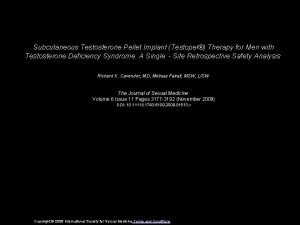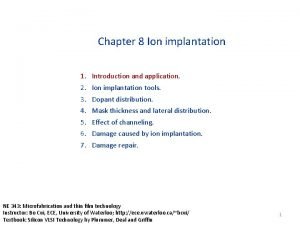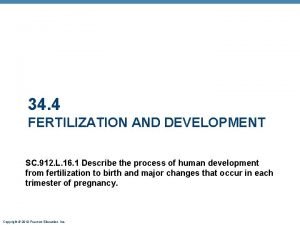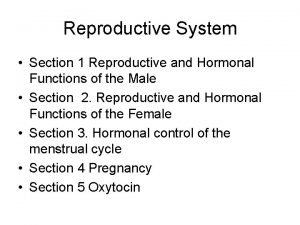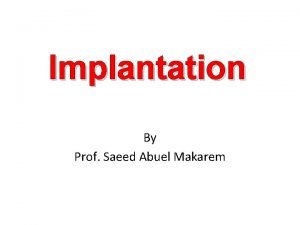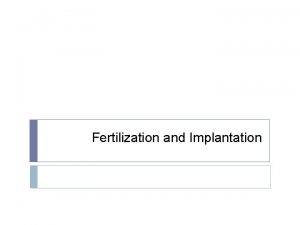IMPLANTATION Implantation is a process in which a







- Slides: 7

IMPLANTATION • Implantation is a process in which a developing embryo, moving as a blastocyst through a uterus, makes contact with the uterine wall and remains attached to it until birth. The lining of the uterus (endometrium) prepares for the developing blastocyst to attach to it via many internal changes. Without these changes implantation will not occur, and the embryo sloughs off during menstruation. Such implantation is unique to mammals, but not all mammals exhibit it. Furthermore, of those mammals that exhibit implantation, the process differs in many respects between those mammals in which the females have estrous cycles, and those mammals in which the females have menstrual cycles. Females in the different species of primates, including humans, have menstrual cycles, and thus similar processes of implantation. • Site: • The normal site of implantation is the posterior wall of uterus near the fundus. • Time: • It begins about the 6 th day after fertilization. • It is completed by the 11 th or 12 th day.

• Before embryogenesis begins, the ovary releases an unfertilized egg cell, called an oocyte, which then travels down the fallopian tube. The egg is enveloped in an extracellular matrix called the zona pellucida. Sperm can fertilize the egg in the zona pellucida (ZP), which prevents the fertilized egg, called a zygote, from adhering to the wall of the fallopian tube. If the zygote implants in any area besides the uterus, the result is an ectopic pregnancy. This condition prevents the complete development of the embryo, and it can cause fatal hemorrhaging in the preganant female. • As the zygote moves through the fallopian tube it undergoes several rounds of cell division, a process called cleavage. These cell divisions produce the inner cell mass (ICM), which will become the embryo, and the trophoblast, which surrounds the ICM and interacts with maternal tissues. Together, the ICM and the trophoblast are called the blastocyst. A blastocyst successfully implants in the uterus when, as the ZP exits the fallopian tube, the blastocyst leaves the ZP and binds to the endometrium.

• The endometrium is one of the few uterine surfaces to which a blastocyst cannot always implant. The properties of the endometrium change, and only in a brief window can the blastocyst implant on the tissue. In humans, that window includes days six through ten after ovulation. Just prior to ovulation, the endometrium begins to thicken and to expand in response to the release of estrogen from the ovaries. As the embryo moves through the fallopian tubes, the endometrium proliferates, changes in shape, becomes receptive to implantation, and produces a hospitable environment for the embryo. Signaled by the release of progesterone from the ovaries, a series of changes called decidualization occurs. Decidualization includes the gathering of white blood cells around endometrial arterioles, or blood vessels leading from arteries to capillary beds. As that vasculature forms, a molecule that stores energy, called glycogen, accumulates in the expanding connective tissues of the uterus. Furthermore, the endometrium swells as interstitial fluid accumulates in it. The endometrium, swollen with interstitial fluid, vasculature, and nutrients, provides a hospitable environment for embryogenesis.

Mechanism: v The Morula reaches the uterine cavity by the 4 th day after fertilization, & remains free for one or two days v Fluid passes from uterine cavity to the Morula through the zona pellucida. Now the Morula is called Blastocyst, its cavity is called blastocystic cavity, its cells divided into Embryoblast & Trophoblast.

The embryoblast projects into the blastocystic cavity, while the trophoblast forms the wall of the blastocyst. • Zona pellucida degenerates & disappears by the 5 th day to allows the blastocyst to increase in size and penetrates the endometrium. • By 6 th day the blastocyst adheres to the endometrium. • By 7 th day, Trophoblast differentiated into 2 layers: 1. Cytotrophblast, inner layer, mitotically active. 2. Syncytiotrophoblast (outer multinucleated mass, with indistinct cell boundary. • By 8 th day the blastocyst is superficially embedded in the compact layer of the endometrium. •

• Blood-filled Lacunae appear in the Syncytiotrophoblast which communicate forming a network by the day 10 th or 11 th • Syncytiotrophoblast erodes the endothelial lining of maternal capillaries which known as sinusoids. Now blood of maternal capillaries reaches the lacunae so Uteroplacental circulation is established by 11 th or 12 th day.

Endometrial cells undergo apoptosis (programmed cell death) to facilitates invasion of endometrium by the Syncytiotrophoblast engulf these degenerating cells for nutrition of the embryo. Implantation can be detected by: 1 - Ultrasonography. 2 - h. CG (human chorionic gonadotrophin which is secreted by the Syncytiotrophoblast) about the end of 2 nd week
